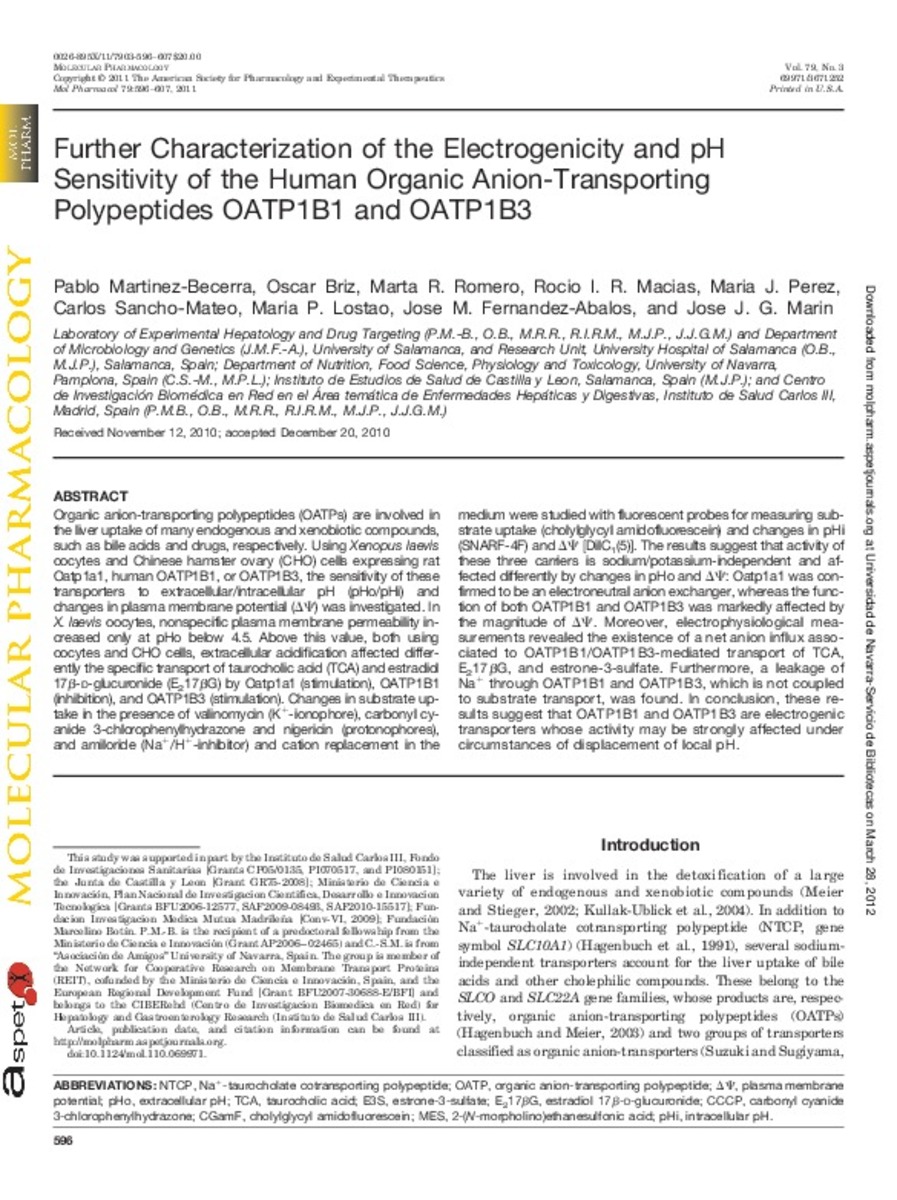Full metadata record
| DC Field | Value | Language |
|---|---|---|
| dc.creator | Lostao, M.P. (María Pilar) | - |
| dc.creator | Martinez-Becerra, P. (Pablo) | - |
| dc.creator | Briz, O. (Oscar) | - |
| dc.creator | Romero, M. (Marta) | - |
| dc.creator | Macias, R. (Rocío) | - |
| dc.creator | Perez, M.J. (Maria J.) | - |
| dc.creator | Sancho-Mateo, C. (Carlos) | - |
| dc.creator | Fernandez-Abalos, J.M. (José M.) | - |
| dc.creator | Marin, J.J.G (Jose J.G.) | - |
| dc.date.accessioned | 2012-04-21T16:43:32Z | - |
| dc.date.available | 2012-04-21T16:43:32Z | - |
| dc.date.issued | 2011 | - |
| dc.identifier.citation | Lostao MP, Martinez-Becerra P, Briz O, Romero M, Macias R, Perez MJ, et al. Further characterization of the electrogenicity and pH sensitivity of the human organic anion-transporting polypeptides OATP1B1 and OATP1B3. Mol Pharm. 2011;79(3):596–607. | es_ES |
| dc.identifier.issn | 0026-895X | - |
| dc.identifier.uri | https://hdl.handle.net/10171/21708 | - |
| dc.description.abstract | Organic anion-transporting polypeptides (OATPs) are involved in the liver uptake of many endogenous and xenobiotic compounds, such as bile acids and drugs, respectively. Using Xenopus laevis oocytes and Chinese hamster ovary (CHO) cells expressing rat Oatp1a1, human OATP1B1, or OATP1B3, the sensitivity of these transporters to extracellular/intracellular pH (pHo/pHi) and changes in plasma membrane potential (ΔΨ) was investigated. In X. laevis oocytes, nonspecific plasma membrane permeability increased only at pHo below 4.5. Above this value, both using oocytes and CHO cells, extracellular acidification affected differently the specific transport of taurocholic acid (TCA) and estradiol 17β-d-glucuronide (E217βG) by Oatp1a1 (stimulation), OATP1B1 (inhibition), and OATP1B3 (stimulation). Changes in substrate uptake in the presence of valinomycin (K+-ionophore), carbonyl cyanide 3-chlorophenylhydrazone and nigericin (protonophores), and amiloride (Na+/H+-inhibitor) and cation replacement in the medium were studied with fluorescent probes for measuring substrate uptake (cholylglycyl amidofluorescein) and changes in pHi (SNARF-4F) and ΔΨ [DilC1(5)]. The results suggest that activity of these three carriers is sodium/potassium-independent and affected differently by changes in pHo and ΔΨ: Oatp1a1 was confirmed to be an electroneutral anion exchanger, whereas the function of both OATP1B1 and OATP1B3 was markedly affected by the magnitude of ΔΨ. Moreover, electrophysiological measurements revealed the existence of a net anion influx associated to OATP1B1/OATP1B3-mediated transport of TCA, E217βG, and estrone-3-sulfate. Furthermore, a leakage of Na+ through OATP1B1 and OATP1B3, which is not coupled to substrate transport, was found. In conclusion, these results suggest that OATP1B1 and OATP1B3 are electrogenic transporters whose activity may be strongly affected under circumstances of displacement of local pH. | es_ES |
| dc.language.iso | eng | es_ES |
| dc.publisher | American Society for Pharmacology and Experimental Therapeutics | es_ES |
| dc.rights | info:eu-repo/semantics/openAccess | es_ES |
| dc.subject | OATP-mediated transport | es_ES |
| dc.subject | Plasma Membrane permeability | es_ES |
| dc.subject | Electrophysiology experiments | es_ES |
| dc.subject | OATP isoforms | es_ES |
| dc.title | Further Characterization of the Electrogenicity and pH Sensitivity of the Human Organic Anion-Transporting Polypeptides OATP1B1 and OATP1B3 | es_ES |
| dc.type | info:eu-repo/semantics/article | es_ES |
| dc.type.driver | info:eu-repo/semantics/article | es_ES |
| dc.identifier.doi | http://dx.doi.org/10.1124/mol.110.069971 | es_ES |
Files in This Item:
Statistics and impact
Items in Dadun are protected by copyright, with all rights reserved, unless otherwise indicated.






